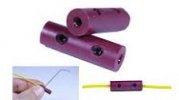Taxiing out the other day, my #1 CHT suddenly spiked to 500+ and bounced around intermittently (this caused a reoccurring alarm, which I couldn't silence). After getting in the menus and turning off the alarm, I took off. In flight, the reading stayed mostly at the high limit, but occasionally bounced around. This continued for awhile, then resolved itself. After shutdown/cool down, the ambient temp read about 25 or so degrees hotter than the rest of the probes. On a subsequent flight, the temp spiked again. My first assumption was that I had a loose connection, or a bad ground, but I read here a post from Dynon that says a probe not connected causes the reading to float. To me, this implies that the reading would just drift around, but mine was more of a bounce, spending most of its time at the high limit. So my question is, doe this sound like a loose connection/intermittent ground, or a bad probe?
You are using an out of date browser. It may not display this or other websites correctly.
You should upgrade or use an alternative browser.
You should upgrade or use an alternative browser.
GKC Aviation
Active Member
- Joined
- Oct 4, 2020
- Messages
- 134
Honestly, it sounds like a bad probe.
If you have a bad connection, which is in essence an open circuit, the Dynon will display a red X over that probe on the screen.
Easy way to fault find is to swap the wiring over between the suspect probe and the cylinder next to it, leaving the probes where they are.
For example, on a Lycoming 4 cylinder, if you had a CHT problem on cylinder 1, then cylinder 3 is right next to it. You would swap the CHT wiring between cylinder 1 and 3, and look to where the fault transferred to. If the fault transferred to cylinder 3, then you have a dead probe. If the fault stayed on cylinder 1, then it's a wiring or EMS problem.
I have also seen probes that have chafed through inside the stainless steel braid at the probe, which causes strange problems as well.
Hope this helps.
If you have a bad connection, which is in essence an open circuit, the Dynon will display a red X over that probe on the screen.
Easy way to fault find is to swap the wiring over between the suspect probe and the cylinder next to it, leaving the probes where they are.
For example, on a Lycoming 4 cylinder, if you had a CHT problem on cylinder 1, then cylinder 3 is right next to it. You would swap the CHT wiring between cylinder 1 and 3, and look to where the fault transferred to. If the fault transferred to cylinder 3, then you have a dead probe. If the fault stayed on cylinder 1, then it's a wiring or EMS problem.
I have also seen probes that have chafed through inside the stainless steel braid at the probe, which causes strange problems as well.
Hope this helps.
jakej
Well-Known Member
Swapping probes is a good cheap test however the 'fault' is most likely with the probe to harness connection. try this simple check - spray the connectors to the probes & then re crimp the connectors.
Ps - if you have the pink supplied connectors then cut them off & throw them out (I always do that with the supplied pink spade connectors & just use the AMP type- no issues after that). Suggest you use the much better AMP /TE brand or OLC types.
Ps - if you have the pink supplied connectors then cut them off & throw them out (I always do that with the supplied pink spade connectors & just use the AMP type- no issues after that). Suggest you use the much better AMP /TE brand or OLC types.
Steveden
Member
Bonwit, Every time that my CHTs have done the exact same thing as yours and its happen numerous times, I've first verified the probe was good by doing what GKC stated. If it tested out good I use the OLC-2 type connects to replace the original crimp connectors and have never had another problem with a probe I've used the OLC's on. You can buy the connectors at Aircraft Spruce, https://www.aircraftspruce.com/catalog/inpages/eioverlapolc-1-10-05470.php or Electronics International, https://www.iflyei.com/product/olc-2/.


I used these and have never had a failure with them.Bonwit, Every time that my CHTs have done the exact same thing as yours and its happen numerous times, I've first verified the probe was good by doing what GKC stated. If it tested out good I use the OLC-2 type connects to replace the original crimp connectors and have never had another problem with a probe I've used the OLC's on. You can buy the connectors at Aircraft Spruce, https://www.aircraftspruce.com/catalog/inpages/eioverlapolc-1-10-05470.php or Electronics International, https://www.iflyei.com/product/olc-2/.
View attachment 5167
GKC Aviation
Active Member
- Joined
- Oct 4, 2020
- Messages
- 134
First thing to go in the rubbish bin when I unpack an EMS engine kitPs - if you have the pink supplied connectors then cut them off & throw them out (I always do that with the supplied pink spade connectors & just use the AMP type- no issues after that)
